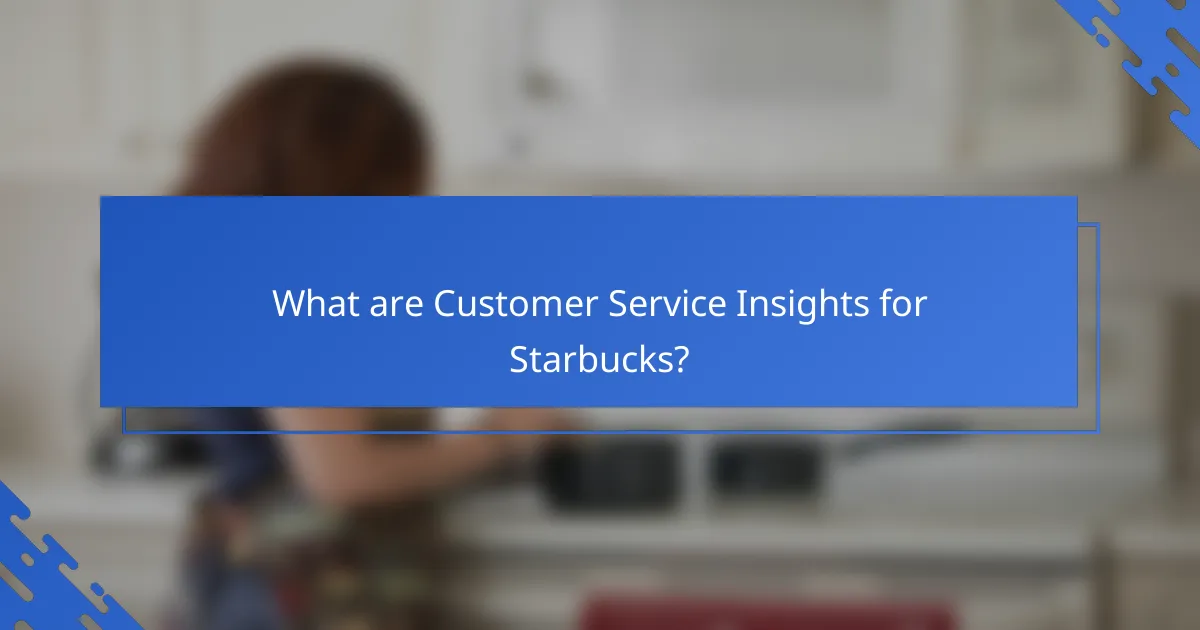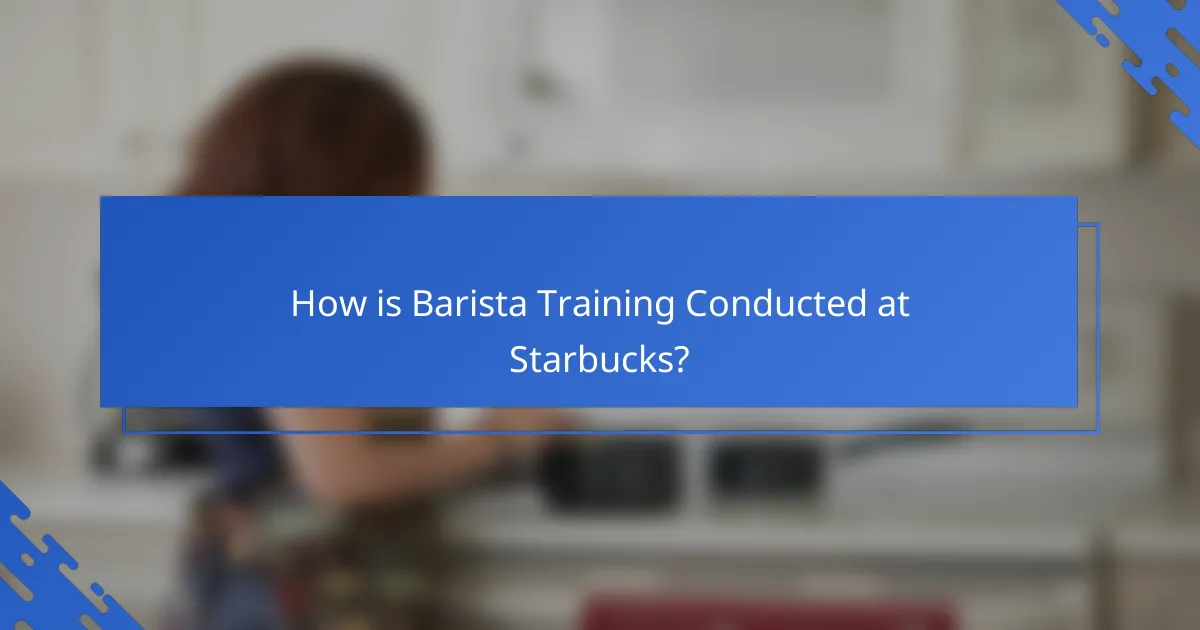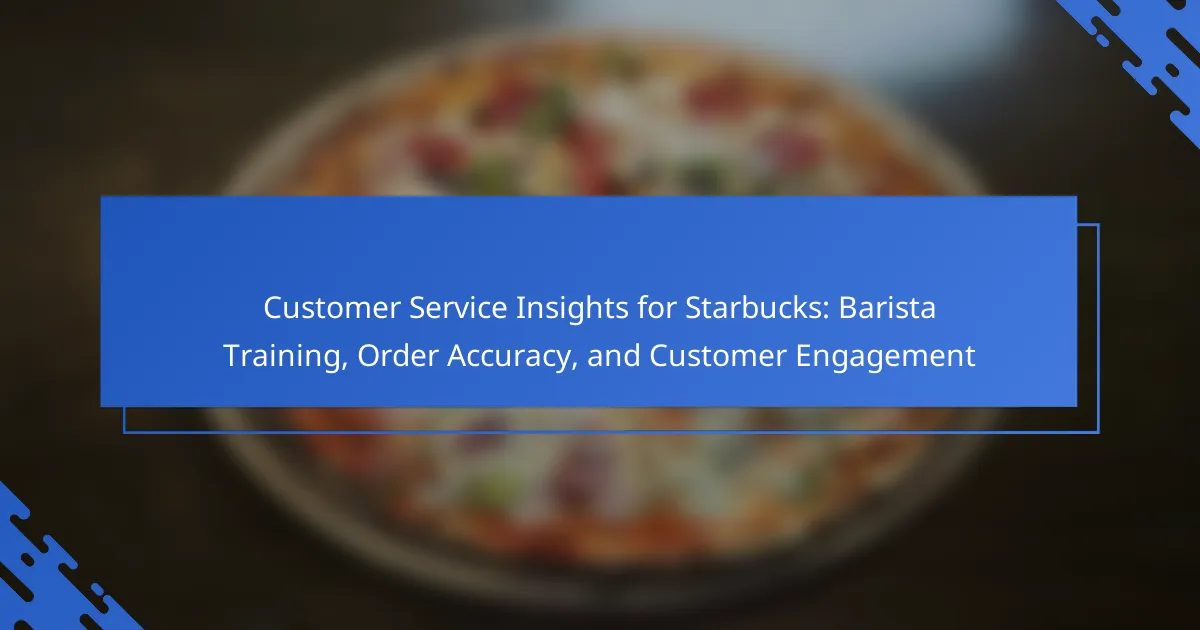The article focuses on customer service insights for Starbucks, highlighting three key areas: barista training, order accuracy, and customer engagement. Barista training at Starbucks is structured to enhance product knowledge and customer interaction skills, utilizing a mentorship model and continuous learning opportunities. Order accuracy is emphasized as a critical factor for customer satisfaction, with Starbucks aiming for a 95% accuracy rate to foster repeat business. Additionally, customer engagement strategies such as personalized service and loyalty programs are outlined, along with the importance of collecting customer feedback to improve service quality.

What are Customer Service Insights for Starbucks?
Customer service insights for Starbucks include effective barista training, high order accuracy, and strong customer engagement. Barista training focuses on product knowledge and customer interaction skills. This training ensures employees can provide recommendations and handle customer inquiries efficiently. Order accuracy is critical to customer satisfaction. Starbucks aims for a high accuracy rate in fulfilling orders, minimizing errors. Customer engagement strategies include personalized service and loyalty programs. These initiatives foster a connection with customers and encourage repeat visits. Starbucks regularly collects customer feedback to improve service quality. This feedback loop helps identify areas for improvement and enhances the overall customer experience.
How does customer service impact the Starbucks experience?
Customer service significantly enhances the Starbucks experience. Positive interactions with baristas create a welcoming atmosphere. Customers feel valued when staff are attentive and friendly. Efficient service reduces wait times, improving overall satisfaction. Starbucks’ training programs emphasize customer engagement. This focus leads to personalized recommendations and tailored experiences. According to a 2022 survey, 85% of customers reported satisfaction due to staff interactions. Strong customer service fosters loyalty and repeat visits. Ultimately, exceptional service is integral to Starbucks’ brand identity.
What role does barista training play in customer service?
Barista training plays a crucial role in customer service by equipping staff with essential skills and knowledge. It enhances employees’ understanding of coffee preparation and beverage customization. Trained baristas can create high-quality drinks consistently, leading to increased customer satisfaction. Moreover, training fosters effective communication skills, enabling baristas to engage positively with customers. This engagement builds rapport and encourages repeat business. Research shows that well-trained staff can significantly improve customer loyalty and overall experience. For instance, a study by the National Coffee Association found that 78% of customers appreciate knowledgeable baristas. Therefore, comprehensive barista training directly impacts the quality of customer service in coffee establishments.
How does order accuracy influence customer satisfaction?
Order accuracy significantly influences customer satisfaction. When customers receive their orders correctly, they feel valued and respected. High order accuracy leads to a positive experience, fostering customer loyalty. Conversely, incorrect orders can result in frustration and dissatisfaction. Research indicates that 70% of customers are likely to return if their order is accurate. In contrast, 50% of customers may not return after a wrong order. Thus, order accuracy directly correlates with repeat business and overall satisfaction.
Why is customer engagement important for Starbucks?
Customer engagement is crucial for Starbucks because it fosters brand loyalty and drives sales. Engaged customers are more likely to return and make repeat purchases. According to a study by Gallup, highly engaged customers can contribute up to 23% more in profitability. Starbucks utilizes loyalty programs to enhance customer engagement. These programs encourage repeat visits and increase average transaction values. Additionally, engaged customers often promote the brand through word-of-mouth. This organic promotion can attract new customers. Therefore, customer engagement directly impacts Starbucks’ revenue and market presence.
What strategies does Starbucks use to enhance customer engagement?
Starbucks enhances customer engagement through personalized experiences and loyalty programs. The Starbucks Rewards program incentivizes repeat purchases by offering points for every transaction. Customers can redeem these points for free drinks and food items. This program fosters a sense of belonging among members. Additionally, Starbucks uses mobile app features for convenience. Customers can order ahead, pay via the app, and earn rewards simultaneously. The app also provides tailored promotions based on purchase history. Furthermore, Starbucks engages customers through community events and local store initiatives. These efforts build a connection between the brand and its customers. Overall, Starbucks employs various strategies to create a loyal customer base and enhance engagement.
How can customer feedback improve service quality?
Customer feedback can significantly improve service quality by identifying areas needing enhancement. It provides direct insights into customer experiences and expectations. For instance, feedback can reveal issues with order accuracy and speed of service. Addressing these concerns can lead to better training for baristas. Improved training enhances staff performance and customer satisfaction. Additionally, regular feedback collection fosters a culture of continuous improvement. According to a study by the Harvard Business Review, companies that actively seek customer feedback experience higher customer loyalty and retention. This demonstrates the tangible benefits of integrating customer feedback into service quality strategies.

How is Barista Training Conducted at Starbucks?
Barista training at Starbucks is conducted through a structured program that includes both classroom instruction and hands-on experience. New hires participate in an initial orientation that covers company values and customer service expectations. Following orientation, trainees engage in barista basics training, learning about coffee preparation and equipment use. This phase includes practical exercises to build skills in drink-making and customer interaction.
Starbucks employs a mentorship model, pairing trainees with experienced baristas for guidance. This mentorship enhances learning and fosters a supportive environment. Additionally, training involves assessments to ensure competency in various tasks, including drink customization and order accuracy.
Starbucks emphasizes continuous learning, encouraging baristas to further their skills through ongoing training sessions and workshops. This approach ensures that all baristas maintain high standards of service and product quality.
What are the key components of barista training?
The key components of barista training include coffee knowledge, equipment operation, and customer service skills. Coffee knowledge covers bean types, brewing methods, and flavor profiles. Equipment operation involves training on espresso machines, grinders, and brewing devices. Customer service skills focus on communication, order taking, and handling customer inquiries. Additionally, hygiene and safety practices are essential for maintaining a clean workspace. Training often includes hands-on practice and role-playing scenarios to enhance skills. These components ensure baristas can provide high-quality beverages and excellent customer experiences.
How does hands-on training contribute to skill development?
Hands-on training significantly enhances skill development by providing practical experience. This type of training allows individuals to apply theoretical knowledge in real-world scenarios. For example, baristas at Starbucks learn to operate equipment and prepare beverages through direct practice. Research shows that experiential learning increases retention rates by up to 75%. Additionally, hands-on training fosters problem-solving skills as trainees encounter and resolve challenges on the job. Engaging with customers during training also improves communication and interpersonal skills. Overall, hands-on training is crucial for developing the competencies needed in customer service roles.
What knowledge do baristas gain about coffee and beverages?
Baristas gain extensive knowledge about coffee and beverages. They learn about different coffee beans and their origins. Baristas understand the brewing methods, such as espresso, pour-over, and French press. They acquire skills in milk frothing and latte art techniques. Baristas become familiar with beverage recipes and flavor profiles. They also study the importance of grind size and extraction time. Knowledge of equipment maintenance and operation is essential. Baristas often receive training on customer service and product recommendations.
Why is continuous training essential for baristas?
Continuous training is essential for baristas to maintain high-quality service and product knowledge. The coffee industry constantly evolves with new brewing techniques and product offerings. Baristas must stay updated on these changes to meet customer expectations. Regular training enhances skills in customer engagement and order accuracy. It also ensures consistency in beverage preparation, which is crucial for brand reputation. Research shows that well-trained baristas contribute to higher customer satisfaction rates. For instance, a study by the National Coffee Association highlights that knowledgeable staff significantly improve the overall customer experience. Continuous training ultimately leads to increased employee confidence and retention.
What ongoing training programs does Starbucks offer?
Starbucks offers ongoing training programs that include Barista Basics, Coffee Knowledge, and Customer Service Excellence. Barista Basics provides foundational skills in beverage preparation and equipment handling. Coffee Knowledge enhances understanding of coffee sourcing, brewing methods, and flavor profiles. Customer Service Excellence focuses on improving customer interactions and engagement techniques. These programs are designed to ensure consistent service quality and product knowledge. Starbucks regularly updates its training materials to reflect new products and customer service strategies.
How do baristas stay updated with new products and techniques?
Baristas stay updated with new products and techniques through continuous training and education. Starbucks provides regular training sessions for baristas to learn about new menu items and brewing methods. They also have access to online resources, including videos and articles, that cover the latest trends in coffee and customer service. Additionally, baristas participate in workshops and industry events to network and gain insights from experts. This ongoing education helps ensure that baristas can deliver high-quality beverages and exceptional customer service.

What is the Importance of Order Accuracy at Starbucks?
Order accuracy at Starbucks is crucial for customer satisfaction. It directly impacts the overall customer experience. Accurate orders lead to repeat business and positive reviews. Starbucks aims for a 95% order accuracy rate. This statistic reflects their commitment to quality service. High order accuracy reduces waste and operational costs. It also enhances employee efficiency and morale. Satisfied customers are more likely to recommend Starbucks to others.
How does order accuracy affect customer loyalty?
Order accuracy significantly influences customer loyalty. When customers receive their orders correctly, they feel valued and satisfied. This satisfaction fosters a positive emotional connection to the brand. A study by the Harvard Business Review found that 70% of customers are more likely to return if their order is accurate. Conversely, frequent inaccuracies can lead to frustration and loss of trust. Customers may choose competitors if their expectations are not met. Thus, maintaining high order accuracy is essential for retaining loyal customers.
What systems are in place to ensure order accuracy?
Starbucks employs several systems to ensure order accuracy. These systems include a point-of-sale (POS) system that captures order details accurately. Baristas receive real-time order information displayed on screens. This minimizes the chances of miscommunication. Additionally, Starbucks implements a double-check system where orders are verified before being served. Baristas are trained to repeat orders back to customers for confirmation. Regular audits and feedback loops are established to assess order accuracy. These measures collectively contribute to maintaining high standards in order fulfillment.
How do baristas double-check orders before serving?
Baristas double-check orders before serving by verifying the details on the order ticket. They compare the ticket with the prepared items to ensure accuracy. Baristas also cross-reference the customer’s name and order specifications. This process helps to avoid mistakes and enhance customer satisfaction. Many coffee shops implement a system where baristas repeat the order back to customers. This verbal confirmation minimizes errors. Additionally, baristas may use visual cues, such as color-coded cups, to ensure the right drinks are served. This method is effective in busy environments. Studies show that double-checking orders can significantly reduce customer complaints.
What are the common challenges in maintaining order accuracy?
Common challenges in maintaining order accuracy include miscommunication between staff and customers. This can lead to incorrect orders being fulfilled. Another challenge is the high volume of orders during peak hours. Increased pressure can result in mistakes. Additionally, staff training plays a crucial role in order accuracy. Inadequate training can lead to misunderstandings of menu items. Equipment malfunctions can also contribute to errors in order processing. Lastly, distractions in a busy environment can cause lapses in attention. These factors collectively hinder the ability to maintain order accuracy effectively.
How can technology assist in improving order accuracy?
Technology can significantly enhance order accuracy through automation and real-time data analysis. Automated systems reduce human error by standardizing order entry processes. For instance, point-of-sale systems can automatically verify orders against inventory. Real-time data analytics can identify patterns and discrepancies in orders. This allows for immediate corrections before orders are finalized. Mobile apps and self-service kiosks enable customers to confirm their orders before submission. Additionally, integrating AI can predict customer preferences, further minimizing mistakes. Research shows that businesses using technology for order management see up to a 30% improvement in accuracy.
What training do baristas receive to minimize errors?
Baristas receive comprehensive training to minimize errors in order preparation. This training includes learning standard operating procedures for drink preparation. Baristas practice using espresso machines and grinders to ensure consistency. They are trained on the importance of double-checking orders before serving. Role-playing scenarios help baristas handle customer interactions effectively. They also learn to identify common mistakes and how to rectify them. The training emphasizes attention to detail and time management. Regular assessments ensure that baristas maintain high standards in order accuracy.
What best practices can enhance customer engagement at Starbucks?
Implementing personalized customer experiences enhances engagement at Starbucks. Personalization can include remembering customer names and their favorite orders. This approach fosters a sense of belonging and loyalty. Additionally, utilizing the Starbucks Rewards program encourages repeat visits. Customers earn points for purchases, which can be redeemed for free drinks. Engaging customers through social media also builds community. Starbucks frequently interacts with customers on platforms like Instagram and Twitter. Offering limited-time seasonal drinks creates excitement and urgency. This strategy encourages customers to visit more often. Training baristas to provide exceptional service is crucial. Friendly, knowledgeable staff can significantly improve customer satisfaction.
How can personalized service improve the customer experience?
Personalized service enhances the customer experience by creating tailored interactions. It allows businesses to meet individual preferences and needs. For example, Starbucks baristas can remember a customer’s name and their favorite drink. This personal touch fosters a sense of belonging. Studies show that personalized experiences lead to higher customer satisfaction. According to a report by Epsilon, 80% of consumers are more likely to make a purchase when brands offer personalized experiences. Personalized service also encourages customer loyalty. Loyal customers are more likely to return and recommend the brand to others. Thus, personalized service is a crucial factor in improving the overall customer experience.
What role does social media play in customer engagement strategies?
Social media is a crucial tool in customer engagement strategies. It allows brands to interact directly with customers in real-time. This interaction fosters a sense of community and loyalty among customers. According to a 2021 survey, 54% of consumers prefer to engage with brands on social media. Social media also provides valuable feedback from customers, enabling brands to adapt their services. For instance, Starbucks uses social media to gather insights on customer preferences. This data helps improve product offerings and customer experiences. Overall, social media enhances communication and strengthens brand-customer relationships.
How can baristas create memorable interactions with customers?
Baristas can create memorable interactions with customers by engaging in personalized conversations. They should remember regular customers’ names and orders. This builds rapport and fosters loyalty. Baristas can also ask open-ended questions to encourage dialogue. Providing recommendations based on customer preferences enhances the experience. Additionally, maintaining a warm and friendly demeanor makes customers feel valued. Positive body language, such as smiling and eye contact, reinforces connection. Creating a welcoming atmosphere through thoughtful interactions leads to lasting impressions. Studies show that personalized service increases customer satisfaction and repeat business.
The main entity of the article is customer service insights for Starbucks, focusing on barista training, order accuracy, and customer engagement. The article outlines the significance of effective barista training in enhancing product knowledge and customer interaction skills, which leads to improved order accuracy and customer satisfaction. It also discusses the importance of customer engagement strategies, such as personalized service and loyalty programs, in fostering brand loyalty and driving sales. Additionally, the article emphasizes the role of customer feedback in continuously improving service quality and the various training programs that ensure baristas remain knowledgeable and skilled.
